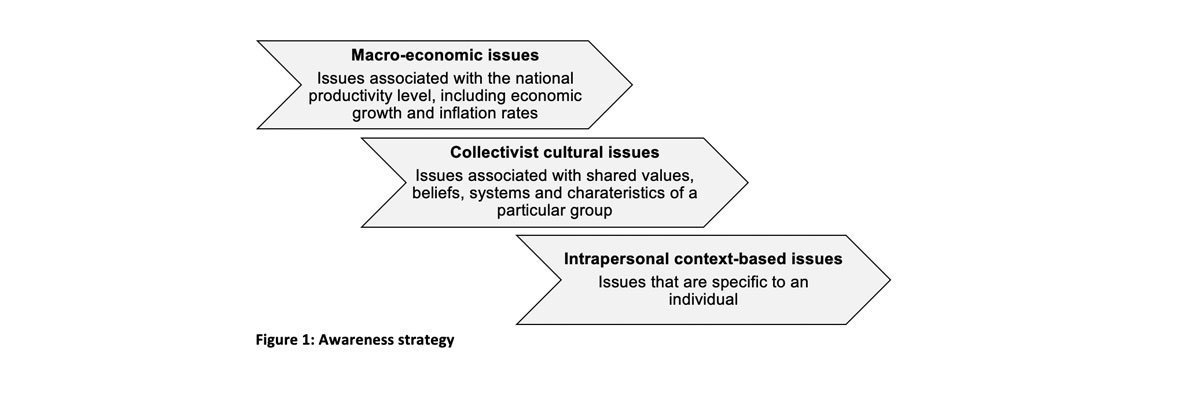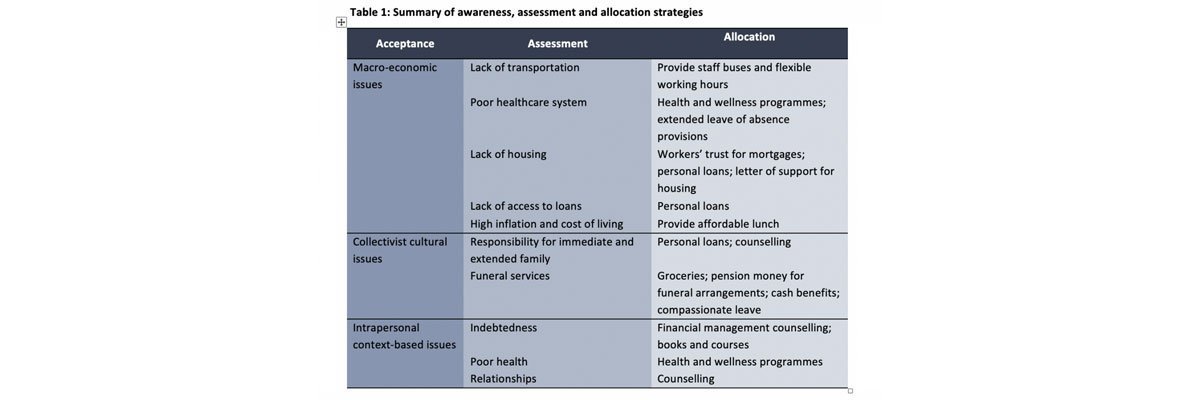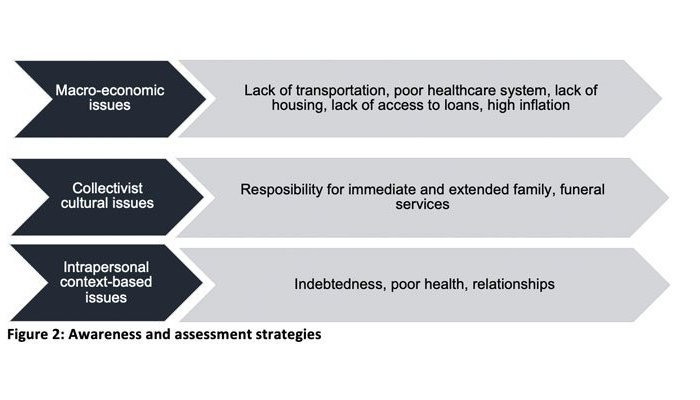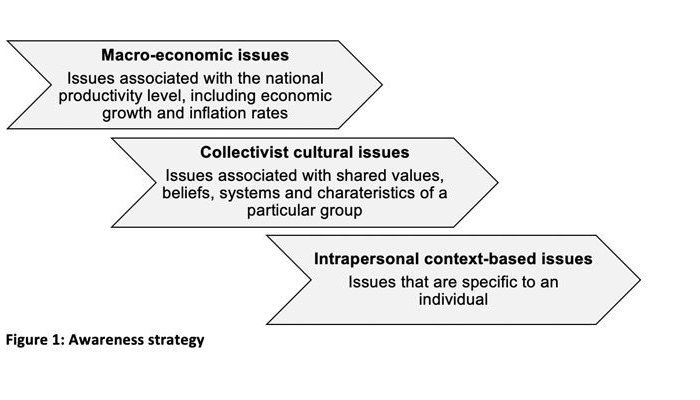While the coronavirus outbreak exemplifies an unexpected and global stressor, what if we turn our attention to a level of stress which continues not for days or months, but years and decades? Consider, for a moment, issues such as poor healthcare services, inadequate transport options, chronic poverty and slow economic growth. What if your workforce is dealing with these stressors on a daily basis? How could this not have a pervasive impact on personal behaviour and business effectiveness?
As our recent GIBS white paper points out, external stressors are ever-present, and not just in the midst of a global health contagion. In Africa, the influence of these stressors on the daily work experience is extreme and ongoing.
In The 4 As: Response Strategy to Stressors that Negatively Influence Employees’ Positive Work Behaviour, we examined the influence of employee stress on businesses operating in five sub-Saharan African countries: Namibia, Botswana, Zimbabwe, Kenya and Nigeria.
We interviewed 33 HR directors and vice presidents across South African, European and home-grown multinational companies operating in finance, agribusiness and retail about the challenges of managing in the African context. During these interviews, many managers mentioned how employees were struggling with stressors from the wider environment. We examined their responses and arrived at a four-part response strategy model which we dubbed ‘The 4 As’.
...external stressors are ever-present...
The first ‘A’: Awareness
The initial step in dealing with employee stressors is to be aware that there are undesired issues or conditions that impact workers. The managers we spoke to identified three important types of issues: challenges from the macro-economic environment, collectivist cultural practice, and non-work personal issues.

Figure 1: Awareness strategy
...in the African context there is no shortage of macro-economic stressors of which managers must be aware...
Macro-economic environmental factors such as poverty were roundly regarded as being a critical issue. In fact, in the African context there is no shortage of macro-economic stressors of which managers must be aware. These range from infrastructural challenges such as a lack of transportation to a shortage of homes that can be rented, coupled with a widespread inability to qualify for mortgage bonds, which impacts basic living conditions. Poor national healthcare might also require employees to queue for a whole day to receive treatment.
As one Nigeria-based HR manager observed: “People are challenged by the harshness of the overall macro economy, so it is tough to operate in an environment like Nigeria without stress.”
But it is not only macro-economic issues which put a strain on employees. Culture plays a role, too.
Many managers stressed the collectivist nature of African societies, which encourage and reward loyalty and care to the group. Frequently, employees must care for not only themselves and their immediate family, but also their extended family and close friends. This is especially true in countries facing widespread poverty and unemployment, where the obligations imposed by collectivism can become a liability – and significant stressor – for employees.
Managers are aware that these collectivist traditions impact productivity. Cultural practices around funeral traditions are a case in point, with some burial services running into days for both immediate and extended family members.
Similarly, managers are faced with the impact of personal stressors and how best to deal with complex intrapersonal considerations such as health and family. Financial pressures and high levels of indebtedness are prime examples of intrapersonal stressors which, in turn, can lead to stress-related conditions such as diabetes and hypertension.
The second ‘A’: Assessment
Once awareness around an issue has been generated, managers must then embark on a costs and benefits assessment, which involves the systemic analysis of the benefits of addressing employees’ stressors against the costs of those interventions.
For example, a cost and benefits assessment would crystallise whether an intervention to reduce waiting times would provide adequate returns in order to be justifiable. Similarly, for a Namibian retailer, it helped to determine a policy of restricting or limiting the attendance of employees at funerals, even that of a fellow employee, since the costs associated with closing a branch or business for a day could not be warranted.

Figure 2: Awareness and assessment strategies
Another notable example came from Zimbabwe where, during the country’s financial crisis, employees spent hours queuing at banks to draw their money in order to buy essential groceries. This led to reduced staff members being available and lower productivity in companies. As a result, manufacturing or sales companies in Zimbabwe introduced depots for customers and staff to buy directly from them. Other businesses, especially in the financial services sector, helped employees to access their funds through alternative channels. These interventions reduced the time employees were spending queuing at the bank, so absenteeism decreased – as did stress – and company productivity improved. For the companies involved, the benefits of implementing these solutions certainly outweighed the costs.
The third ‘A’: Allocation
Once the company has identified the likely returns on different potential strategies, it needs to allocate resources to the one that adds the most value. Of course, the availability of resources remains a challenge and while the managers interviewed said they tried to help employees using their company’s limited resources, allocated funds often ran out. As a Zimbabwean agribusiness HR manager said: “As usual, as the coffers dry up for the company, it becomes more and more difficult.”
The resources allocated to interventions designed to tackle macro-economic stressors, for example, might include the decision by a European finance multinational based in Nigeria to provide staff busses to take employees to and from work. Other interventions might include the adoption of western HR practices, such as flexible hours and job designs.
Cultural stressors, such as the death of an immediate family member, might be addressed through psychological support and counselling, or cash benefits and grocery parcels. In the case of an immediate family member’s death, some companies provide groceries and funds to cover funeral expenses.
Similarly, when it comes to addressing intrapersonal stressors, resources might be directed towards financial and health-wellness programmes, or counselling. Some companies addressed issues such as financial indebtedness by supplying financial wellness programmes and educational books. One company even introduced dance lessons as a less costly method of helping employees to de-stress.

The fourth ‘A’: Adaptation
Finally, strategies require continuous modification to respond to the dynamic macro-economic changes that characterise emerging markets, and the collectivist cultural and intrapersonal challenges that result. As one interviewee from a Namibian multinational retailer noted: “Things can change in the wink of an eye; you must adapt to that. You can’t say the one formula will work all the time.”
However, in times of threatened profitability and sustainability, change and disruption, it might not be feasible for companies to support employees in all the ways they would like. Businesses should interrogate the role they can play in acknowledging stressors and finding ways to support staff, while employees should be encouraged to come up with innovative solutions to address some of their own challenges.
...strategies require continuous modification...
What should African companies be doing?
On a practical level, companies should focus on engaging both internally as well as externally in an effort to address the impact of stressors on their workforce.
On an organisational level, the biggest takeaway for companies operating across the continent is to engage with government. A head-in-the-sand approach will not help to address the raft of economic, social and environmental challenges facing many African countries. Rather, companies must engage with governments, share expertise and help formulate collective strategies to tackle pressing problems and to stimulate growth.
Similarly, the private sector should be encouraged to reinvest in the countries in which they do business. Such reinvestments should be supported by relevant government actions (such as tax incentives), particularly when such investments lead to sustainable job creation.
It is equally critical that organisations practice what they preach internally. This could include ensuring that policies are in place which consider the contexts in which companies operate, while being mindful of the nature of the organisation and the type of interventions that would be advisable and practical to implement.
On a managerial level, the focus should be on the health, wellness and social well-being of employees. This means ensuring that adequate resources are in place, that balanced and flexible work schedules are drawn up, that employees are engaged with to monitor stress levels, and that positive and supportive work behaviours are instituted and promoted.
This is not a top-down approach, but one that requires an interplay as dynamic and changeable as the current macro-economic climate. It requires an acknowledgement that human beings are not machines but thinking and feeling individuals who carry worries and stresses with them, particularly in countries battling with social and political challenges. Effective companies and managers should acknowledge this and apply ‘The 4 As’ to help support their workforce.
KEY TAKEAWAYS
· Employees absorb external stressors and bring these issues to work. This inevitably impacts productivity and business effectiveness.
· Managers across five sub-Saharan African countries acknowledge that the macro-economic environment, collectivist cultural practices and non-work personal issues can raise employees’ stress levels.
· By applying ‘The 4 As’, managers can formulate a response strategy to help employees deal with stressors. This, in turn, has positive outcomes for work-related behaviour.
· Managers should facilitate open dialogue and effective communication with employees about the stressors affecting them.
· Identifying stressors, having regular check-in meetings and encouraging employees to participate in stress management programmes are just some interventions that increase work-life balance awareness.








